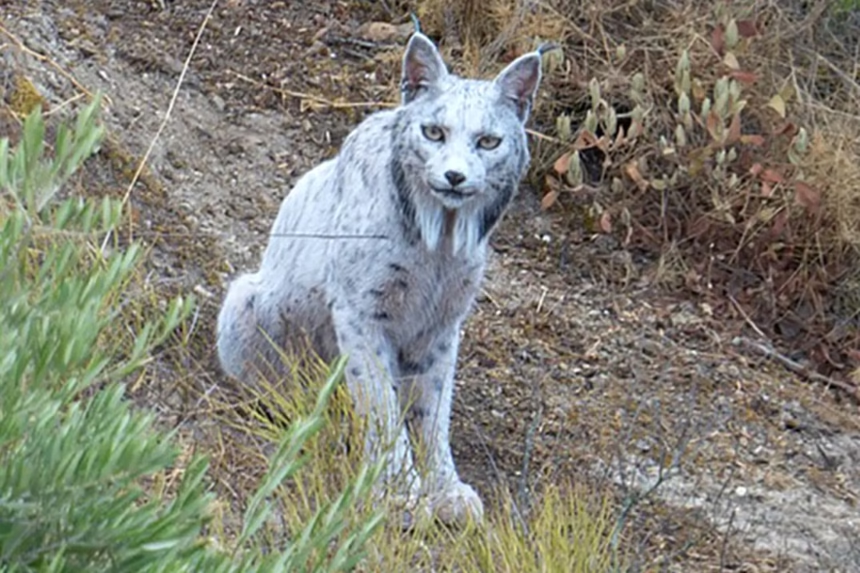A white Iberian lynx, a leucistic form of one of the rarest wild cats, has been filmed in the mountains of Jaén in southern Spain. The footage, recorded by amateur nature photographer Ángel Hidalgo, has sparked worldwide interest and fresh optimism for conservation.
It is the first verified sighting of a white Iberian lynx since the species came close to vanishing two decades ago. The image, showing a cat with snow-white fur and bright yellow eyes, spread quickly online and drew millions of views, a reminder of the fragile gains made in restoring biodiversity.
The Iberian lynx (Lynx pardinus), often nicknamed the ghost of the Mediterranean forest, is found only in Spain and Portugal. Unlike the usual tawny, spotted coat, this individual shows leucism, a genetic trait that reduces pigment in the fur while leaving the eyes their normal colour.
It is not albinism, which affects vision and produces red eyes. “This is something truly unique,” Hidalgo said after checking his trail camera. “I froze when I saw it, it seemed to shine against the rocks.”
To protect the cat from harm, authorities are keeping the exact site within Sierra de Cazorla Natural Park confidential. The UNESCO Biosphere Reserve is known for its oak woods, Mediterranean scrub and rolling hills. Thick scrub and broken terrain give the lynx the cover it needs to ambush its favourite prey, the European rabbit.
The White Iberian Lynx Glimmer of Return
The White Iberian lynx crashed in the 20th century after centuries of pressure. Hunting and poaching for pelts cut numbers, while farmland, towns and roads sliced up its habitat and isolated remaining groups. The biggest hit came from the loss of rabbits, which were decimated by myxomatosis in the 1950s and rabbit hemorrhagic disease in the 1980s.
By 2002, only 94 animals survived in two pockets in Andalusia. The IUCN listed the species as critically endangered and warned of its possible disappearance. “It was a genetic bottleneck,” said Dr Maria López of WWF Spain. “Inbreeding reduced diversity, making traits like leucism even rarer, yet here we are, seeing one appear.”
Records of the species go back centuries. The name lynx comes from the Greek for light, a nod to its reflective eyes. Coenraad Jacob Temminck gave Lynx pardinus its scientific description in 1827 from traded pelts. Folklore across Iberia cast it as a guardian of the wild, but by the mid-1900s, even rumours were scarce. Before the 20th century, experts believed there were tens of thousands, ranging from Portugal’s Tagus River to Spain’s Doñana National Park.
Conservation Success: From Around 100 to Roughly 2,000
The appearance of a white lynx is not a random fluke. It reflects a wider recovery. Since the early 2000s, the EU’s LIFE Iberlince Project, the Spanish and Portuguese governments, and NGOs such as WWF have driven a turnaround built on four pillars:
- Habitat restoration: replanting native scrub and creating corridors that reconnect isolated groups.
- Prey recovery: rebuilding rabbit numbers with vaccination and hunting restrictions, lifting food supplies severalfold in key areas.
- Captive breeding and releases: more than 1,000 lynxes bred under human care have been released since 2011, with radio collars used to track survival and movement.
- Anti-poaching work: tougher laws and local outreach have cut illegal killing.
The results have followed. From 326 animals in 2012, the population rose to 404 adults by 2015 and to about 2,000 by 2025. In June 2024, the IUCN moved the species from endangered to vulnerable, a rare step down the Red List. “This leucistic lynx signals genetic breadth returning,” said López. “A larger, healthier population lets recessive traits show without risking the species.”
Risks remain. A white coat may reduce camouflage in Jaén’s tawny hills, making hunting harder and raising exposure to threats. Climate change adds pressure, shifting rabbit habitat and worsening drought. Continued camera trapping, like Hidalgo’s setup, helps track progress, yet steady funding still matters. As the Iberian Lynx Recovery Program warns, “We have clawed back from the abyss, but complacency could undo it all.”
Echoes of Hope for Wildlife Everywhere
Social media carried the story far. Users called the cat “Mother Nature’s sign” and “a snowy spirit reborn.” Hashtags such as #WhiteIberianLynx and #LynxConservation trended, with many drawing links to other comebacks, including the California condor and the black-footed ferret. Hidalgo’s video on X and Instagram prompted donations to WWF and showed how public support can power conservation.
In Spain, the news is likely to boost eco-tourism in Jaén, where guided lynx tours already draw thousands each year. Globally, it highlights the Iberian lynx as a model for targeted action that bends the curve away from extinction. As Hidalgo put it, “In a world losing species daily, this white lynx shows what happens when we protect the wild.”
Conservation groups are calling for wider corridors that connect with Portugal, along with climate-smart planting. Roadkill and disease still pose threats, so the work goes on. For now, in the quiet folds of Jaén’s hills, a pale hunter moves with silent purpose, a living sign of nature’s grit.
For more on White Iberian lynx conservation, visit:
- IUCN Red List: Iberian Lynx: https://www.iucnredlist.org/species/12530/50657361
- WWF Iberian Lynx Program: https://www.worldwildlife.org/species/iberian-lynx














